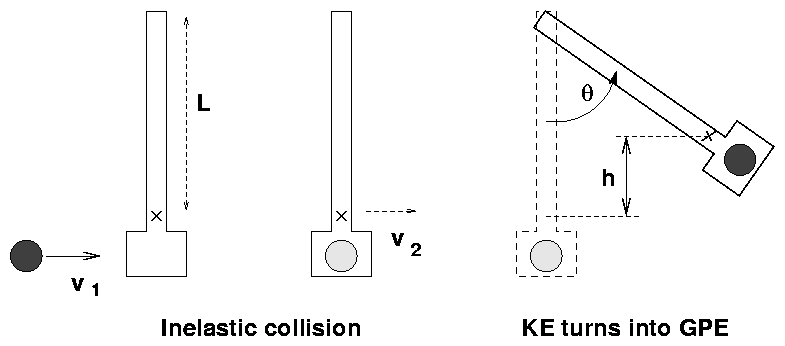Complicated collisions: the ballistic pendulum
In real life, collisions are often messy affairs
which require a mixture of techniques to understand.
As an example, consider the ballistic pendulum.

You can break the action into two pieces.
Please write an equation for each piece:
- A ball of mass m moving at speed v1 slams
into an arm of mass M. Use conservation of
momentum in this completely inelastic collision
to write an equation relating v1 to the velocity
of the arm-plus-ball v2.
- An arm with an initial speed swings up until it halts
at an angle theta.
Use conservation of energy to figure out the relationship
between the speed of the arm-plus-ball v2,
the angle theta,
and the height h by which the center of mass of
arm-plus-ball rises.
Your first job today is to figure out the speed v1 with which the
ball is fired from the catapult, by measuring the angle theta
(and some other quantities).
- be very gentle with the swinging arm
- use the stuffing rods to push the ball into the catapult
- make 3 measurements for the "medium-range" setting
of the spring-loaded gun
- you will need to find the position of the center of mass
of the arm-plus-ball
- watch the device when you fire the catapult. If it slides
across the table, your measurements will be inaccurate:
some of the momentum goes into the motion of the whole
device, which you cannot measure
- try to estimate the uncertainty in each of the four
quantities you need to measure
- You should end up with one table showing
all your measurements,
and the uncertainty associated with
each measurement.
- Which measurement has the largest percentage uncertainty?
If you want to improve this experiment, you should concentrate
on doing this part of it more precisely.
Now, show step-by-step how to use
your measurements to compute
the value of
v1,
the velocity of the ball when it leaves
the muzzle of the gun.
- What is this velocity for the medium-range setting?
Compute the uncertainty in v1,
using the rules for propagating uncertainties.
- What is the uncertainty in the velocity
for the medium-range setting?
As you try to convert the uncertainties in the values you
measured in class into an uncertainty in the initial
speed v1 of the ball,
you may find it useful to peruse
Your second job is to calculate the spring constant k
of the spring in the gun.
Let's use an energy-based measurement:
- Use your measurements of the initial speed
of the ball to compute the kinetic energy
of the ball.
Assume that this kinetic energy (KE) is exactly the
same as the spring potential energy (SPE) stored
in the compressed spring.
-
Measure the distance by which the spring is compressed
for the medium-range setting.
Include an uncertainty with the distance.
-
Compute the spring constant using data from the
medium-range setting
-
Compute an uncertainty in the spring constant for the
medium-range setting

